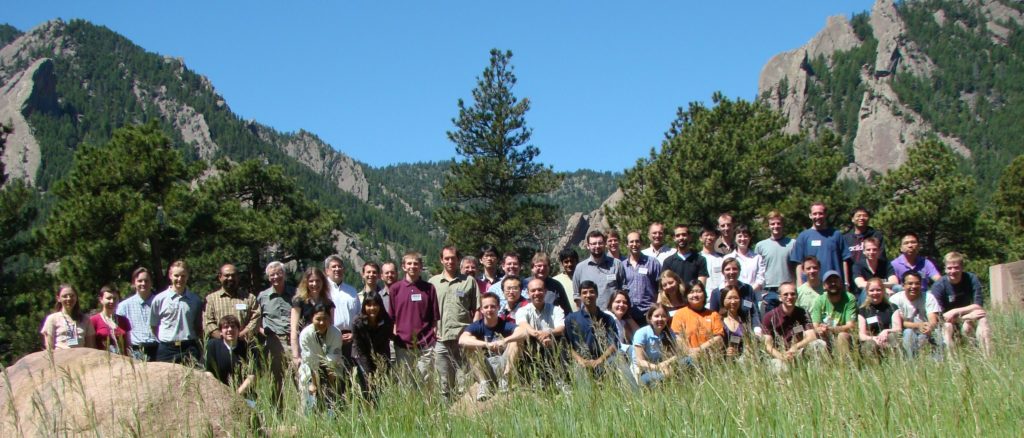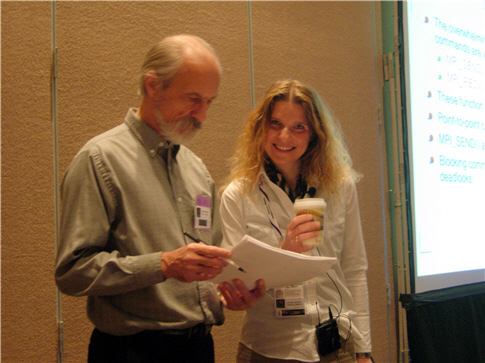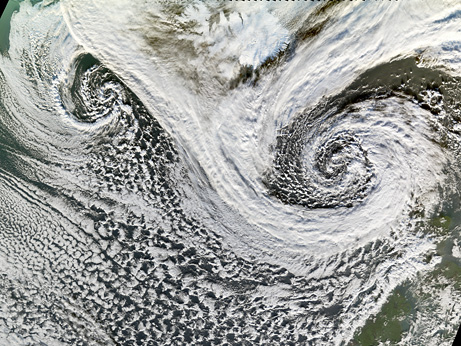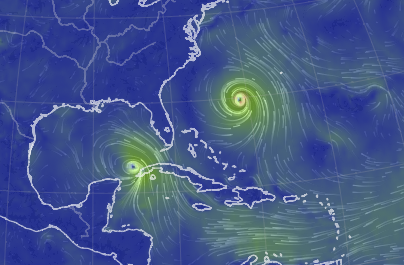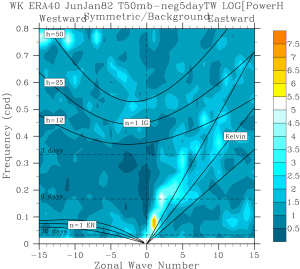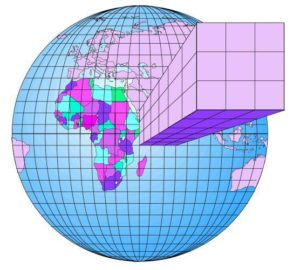DCMIP Summer School on Earth System Model Development
NCAR, Boulder, CO, likely: late May – first week in June 2025 (details to come)
Organized by Peter H. Lauritzen (NCAR), Adam Herrington (NCAR), Christiane Jablonowski (University of Michigan), Hugh Morrison (NCAR), Paul Ullrich (University of California, Davis), Kevin Reed (Stony Brook University), Colin Zarzycki (Penn State University)
The Dynamical Core Model Intercomparison Project (DCMIP) Summer School will highlight the newest modeling techniques for global climate and weather models. It will be held at the National Center for Atmospheric Research (NCAR) in Boulder, CO, in the summer of 2025 (late May / first week in June), and will emphasize ‘physics-dynamics coupling’ and high-resolution modeling as overarching themes. The objectives of the DCMIP Summer School are (1) to teach a group of about 30 multi-disciplinary students and postdocs how today’s and future atmospheric models are or need to be built, and (2) to use idealized test cases to expose selected model design choices in simplified modeling frameworks based on NCAR’s Community Earth System Model (CESM) and the Department of Energy’s (DoE’s) Energy Exascale Earth System Model (E3SM). DCMIP-2025 thereby continues the DCMIP-2008, DCMIP-2012 and DCMIP-2016 model intercomparison and summer school series. It is expected that the DCMIP event will be sponsored by the National Science Foundation (NSF), the Department of Energy (DoE), NCAR and NOAA.
Emerging Data Science and Machine Learning Opportunities in the Weather and Climate Sciences
AGU 2018 Workshop, Washington D.C., Dec/13/2018
Organizing Team: Christiane Jablonowski (University of Michigan), Sudhir Shresta (ESRI), Orhun Aydin (ESRI), Vipin Kumar (University of Minnessota), Imme Ebert-Uphoff (Colorado State University), Daniel Cooley (Colorado State University), Amy McGovern (University of Oklahoma), Kevin Reed (Stony Brook University)
The workshop presented (see the presentations here) how novel data science, data mining, and artificial intelligence techniques can innovate and inform atmospheric modeling practices, physical process studies, knowledge discovery, and the use of massive datasets and observational studies. Particular attention was paid to machine learning concepts, and how machine learning techniques can be enhanced to become aware of physical constraints. The workshop has been highly interdisciplinary. Tutorial-like overview talks first outlined the data science and machine learning opportunities and challenges for the atmospheric sciences. These concepts were then further explored via short application examples and case studies. Participants came from academia, U.S. national research laboratories and funding agencies, international institutions, and industry. The workshop brought together weather and climate researchers, data scientists, statisticians, engineers, tech companies, program managers, educators, students, and other stakeholders to discuss newly emerging data science and machine learning opportunities for the atmospheric sciences. This provided a diverse and stimulating discussion forum to foster future collaborations and partnerships.
The Dynamical Core Model Intercomparison Project (DCMIP-2016) and Summer School:
Future-Generation Non-Hydrostatic Weather and Climate Models
DCMIP-2016 Summer School on Future-Generation Non-Hydrostatic Weather and Climate Models
Boulder, CO, June, 6 – June, 17 2016
Organized by Paul Ullrich (University of California, Davis), Christiane Jablonowski (University of Michigan), Kevin Reed (Stony Brook University), Colin Zarzycki (NCAR), James Kent (University of South Wales, U.K.), Peter H. Lauritzen (NCAR) and Ramachandran D. Nair (NCAR)
We organized this summer school and model intercomparison workshop with a special focus on the newest non-hydrostatic global models. We invited students, postdocs and the international dynamical core modeling community to join us at the National Center for Atmospheric Research (NCAR, Boulder, CO) for 2 weeks from June/6-17/2016 for an exciting student-focused and research-driven event that led to an unprecedented dynamical core intercomparison project. The new aspects were that DCMIP-2016 focused very strongly on idealized dynamical core test cases with simple moisture feedbacks to assess the physics-dynamics coupling and interactions. As DCMIP-2012, DCMIP-2016 has been endorsed by the WMO Working Group on Numerical Experimentation (WGNE). The summer school and model intercomparison workshop is supported by cyberinfrastucture tools like shared workspaces via the Earth System CoG environment.
We explored new test techniques for non-hydrostatic models that are also applicable at hydrostatic scales. Examples are a new moist baroclinic wave test case without topography (applicable to both shallow-atmosphere and deep-atmosphere dynamical core equation sets) and a tropical cyclone test case of intermediate complexity that not only assesses the dynamical core but also includes a ‘simple physics’ package with a Kessler-type warm-rain scheme. It let us investigate non-linear interactions and the physics-dynamics coupling. The third test is a supercell system on a reduced-size Earth that gives insight into non-hydrostatic motions at low computational cost.
The Dynamical Core Model Intercomparison Project (DCMIP-2012) and Summer School:
Future-Generation Non-Hydrostatic Weather and Climate Models
DCMIP-2012 Summer School on Future-Generation Non-Hydrostatic Weather and Climate Models
Boulder, CO, July, 30 – August, 10 2012
Organized by Christiane Jablonowski (University of Michigan), Paul Ullrich (University of California, Davis), James Kent (University of South Wales, U.K.), Kevin Reed (Stony Brook University), Peter H. Lauritzen(NCAR), Ramachandran D. Nair (NCAR) and Mark Taylor (Sandia National Laboratories)
In 2012, we organized a summer school and model intercomparison workshop with special focus on non-hydrostatic global models which were under development in 2012. We invited students and the international dynamical core modeling community to join us at the National Center for Atmospheric Resaearch (NCAR, Boulder, CO) for 2 weeks from July/30-August/10/2012 for an exciting student-focused and research-driven event that will led to an unprecedented dynamical core intercomparison project, even broader in scale than our 2008 workshop. The event was endorsed by the WMO Working Group on Numerical Experimentation (WGNE).
We explored new test techniques for non-hydrostatic models that are also applicable at hydrostatic scales. Examples are our newly developed tropical cyclone test case of intermediate complexity that not only assesses the dynamical core but also includes a ‘simple physics’ package. It lets us investigate non-linear interactions and the physics-dynamics coupling. Other test cases include ‘small Earth’ experiments that give insight into non-hydrostatic motions at low computational cost.
2008 NCAR Advanced Study Program (ASP) Summer Colloquium
Numerical Techniques for Global Atmospheric Models
Boulder, CO, June 1-13, 2008
Organized by Peter H. Lauritzen (NCAR), Christiane Jablonowski (University of Michigan), Mark Taylor (Sandia National Laboratories) and Ramachandran D. Nair (NCAR)
The 2-week summer colloquium titled “Numerical Techniques for Global Atmospheric Models” surveyed the latest developments in numerical methods for the dynamical cores of Atmospheric General Circulation Models. The objectives of the colloquium were (1) to teach a large group of about 40 graduate students in atmospheric science and mathematics how today’s and future dynamical cores are or need to be built, (2) to invite over 10 dynamical core modeling groups to NCAR for an unprecedented student-run dynamical core intercomparison project, (3) to establish new dynamical core test cases in the community and (4) to invite keynote speakers to NCAR that give lectures on modern numerical techniques and innovative computational meshes.
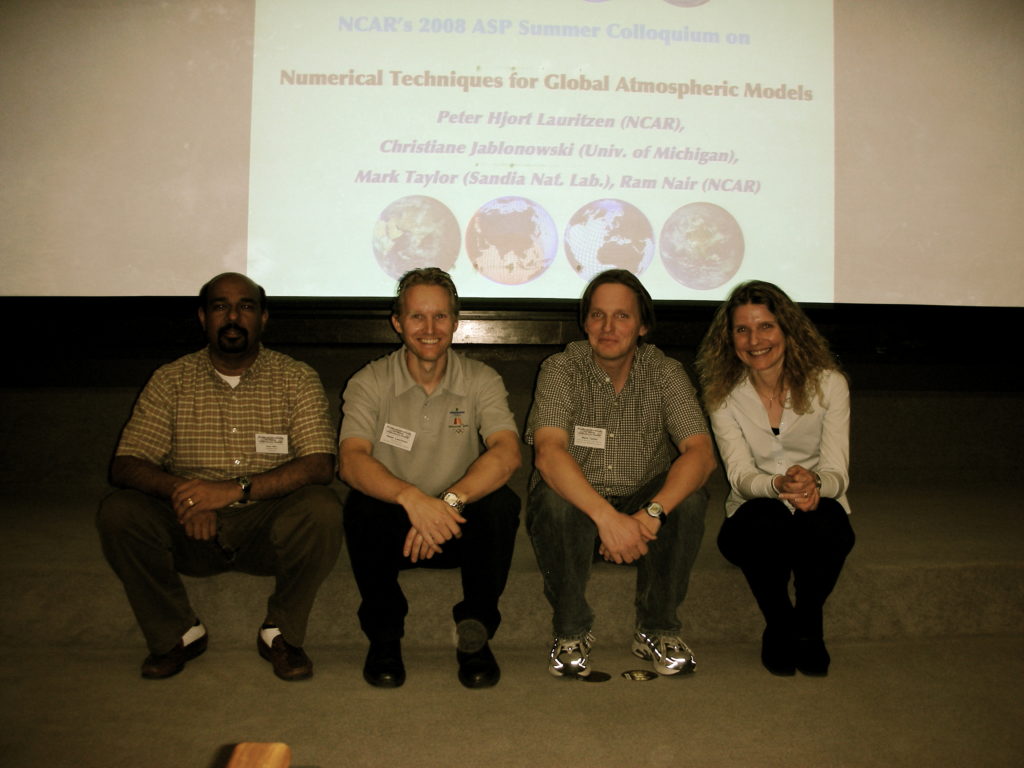
IPAM Long Program: Model and Data Hierarchies for Simulating and Understanding Climate
The Institute for Pure and Applied Mathematics (IPAM) is an NSF Math Institute on the campus of UCLA in Los Angeles, CA. In the spring of 2010 (March 8 – June 11, 2010) IPAM held a 13-week long program on Model and Data Hierarchies for Simulating and Understanding Climate. There were four one-week workshops and a week-long tutorial-workshop (first week) embedded into the long program. The themes of the four workshops addressed (1) the equation sets for climate modeling, (2) the numerical methods and hierarchies, (3) the subgrid-scale physics parameterizations and (4) data analysis and assimilation aspects. We were involved in several of the IPAM events. Prof. Jablonowski was a speaker at the tutorial-workshop, and an organizer (& speaker) of Workshop II: Numerical Hierarchies for Climate Modeling.
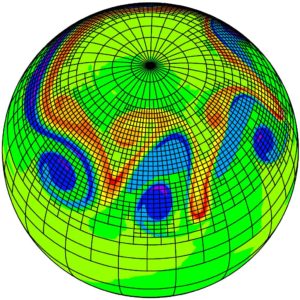
Tutorials on ‘Parallel Computing 101’ at the conference SuperComputing
For over 20 years Prof. Jablonowski has been collaborating with Prof. Quentin Stout (Computer Science and Engineering, University of Michigan) on the Parallel Computing tutorial ‘Parallel Computing 101’ which we update substantially every year. This tutorial provides a comprehensive overview of parallel computing, emphasizing those aspects most relevant to the user. It discusses software and hardware, with an emphasis on standards, portability, and systems that are widely available.
The tutorial surveys basic parallel computing concepts, using examples selected from large-scale engineering and scientific problems. These examples illustrate using MPI on distributed memory systems, OpenMP on shared memory systems, and MPI+OpenMP on hybrid systems. It discusses numerous parallelization approaches, and software engineering and performance improvement aspects, including the use of state-of-the-art tools. The tutorial helps attendees make intelligent decisions by covering the primary options that are available, explaining how they are used and what they are most suitable for. Extensive pointers to the literature and web-based resources are provided to facilitate follow-up studies. In recent years, the number of participants has exceeded 100. Among the participants are managers, students, commercial employees, researchers and software engineers from national research centers. The most recent version of the tutorial was taught at the SuperComputing ’23 conference (SC23) in Denver, CO, on Nov/13/2023.

Photo: Christiane Jablonowski at SC22 in Dallas, TX. The photo was taken by SC22 while Quentin Stout and I presented the ‘Parallel Computing 101’ tutorial. The photo was used in 2023 to promote the SC23 tutorials.
Video Promotion for ‘Parallel Computing 101’: Full-day tutorial at the SuperComputing (SCXX) Conference Series
Click on the video to start the preview.
Undergraduate course at the University of Michigan: Extreme Weather (CLIMATE 102)
This course provides an introduction to the physics of extreme weather events and is designed for non-science majors. The course uses examples of thunderstorms, jet stream, floods, lake-effect snowstorms, lightning, thunder, hail, hurricanes, and tornados to illustrate the physical laws governing the atmosphere. Participants apply these principles in hands-on storm forecasting and weather analysis assignments.

Undergraduate course at the University of Michigan: Earth and Space System Dynamics (CLIMATE 321)
The sophomore course Earth System Dynamics gives an introduction to the dynamics of the atmosphere, oceans, and planets. The course introduces the equations of motion that govern the motions of the Earth’s Systems. We derive the full equation set and then discuss various approximations to study the components of the Earth’s system. The first half of the course addresses the dynamics of the atmosphere and climate system. Special attention is paid to the dominant balances in the atmosphere, like the geostrophic balance or hydrostatic balance. The second half of the course focuses on ocean and planetary dynamics. The course is quantitative and based on physical and mathematical principles.
Figure: Satellite image of the NASA Terra satellite, The image shows two spiraling storms, formed simultaneously above Iceland and Scotland on Jan/2/1007. The air in the low pressure systems rotates counterclockwise as expected in the Northern Hemisphere.
Mixed Undergraduate-Graduate course at the University of Michigan:
Geophysical Fluid Dynamics (CLIMATE 401)
This senior-level / beginning graduate-level atmospheric dynamics course extends the knowledge from CLIMATE 321 (for undergraduates) and serves as a rigorous introduction to atmospheric dynamics for beginning climate graduate students or graduate students from other academic programs. Graduate students with prior knowledge of atmospheric dynamics are advised to take the advanced version CLIMATE 451 (see below). If you are unsure, please reach out to Prof. Jablonowski. The course provides in-depth discussions of the equations of motion for geophysical flows which a focus on the atmosphere. We will approximate the equations in various ways (geostrophic balance, vorticity dynamics, quasi-geostrophic theory) to learn about the essential motions and forces for weather and climate systems on varying temporal and spatial scales. The course will also discuss some wave dynamics, like the discussion of Rossby waves and shallow-water waves, and tropical dynamics.
Figure: Near-surface wind field on 8/29/2023 depicting the developing Hurricane Idalia in the Gulf of Mexico (making landfall in Florida on 8/30/2023) and Hurricane Franklin in the Atlantic. The yellow and red colors indicate higher wind speeds. Source: https://earth.nullschool.net/#2023/08/29/0900Z/wind/surface/level/orthographic
Graduate course at the University of Michigan: Atmospheric Dynamics (CLIMATE 451)
This graduate-level course provides an in-depth discussion of atmospheric motions. We start with a review of the equations of motion and dominant balances, and briefly remind ourselves of the quasi-geostrophic theory. This is our background knowledge. We then discuss waves and instabilities in the atmosphere. This includes the derivation of the dispersion relations for shallow-water, sound, gravity, inertial-gravity, topographic, Rossby, and many tropical waves. In addition, we discuss barotropic, baroclinic, inertial, Kelvin-Helmholtz, symmetric, and static instabilities. The course reviews the general circulation of the atmosphere including the Hadley cells, planetary and equatorial waves and gives an overview of the dynamics of the middle atmosphere. We address the wave-mean flow interaction, wavenumber-frequency diagrams, the mean and transformed Eulerian mean circulation, tropical meteorology, energy and angular momentum budgets, and atmospheric modeling.
Figure: Wheeler-Kiladis wavenumber-frequency diagrams based on ECMWF’s ERA40 reanalysis data set. Left: wavenumber-frequency spectrum for temperature during Jan-Jun 1980 at 50mb altitude, averaged between 10S-10N. Kelvin wave stands out, with wavenumber of about 1 and period of 15-20 days. Right: wavenumber-frequency diagram for temperature during Jun-Nov 1980 at 30mb altitude, averaged between 10S-10N. A Rossby-Gravity wave signal can be picked out at about wavenumber 4-5, with a frequency of about 3-5 days.
Graduate Course at the University of Michigan: The Art of Climate Modeling (CLIMATE 589)
The course discusses how atmospheric general circulation models (GCMs) are or need to be built, thereby exposing the many design choices atmospheric modelers face. The course addresses both the dynamical cores of GCMs and selected physical parameterizations. It is a hands-on class with journal article reviews and many modeling projects that lets us explore NCAR’s newest Community Earth System Model CESM. We utilize modern software and hardware technologies, shared Wiki-based workspaces, learn about numerical methods, model uncertainties and the coupling of model components, develop computing skills and deal with data.
Figure: Left: Example of an idealized simulation with the NCAR Finite-Volume (FV) dynamical core. The figure shows the 850 hPa temperature field of an idealized baroclinic wave as documented by Jablonowski and Williamson (QJ, 2006) and in the Jablonowski and Williamson NCAR Technical Report TN-469+STR (2006). Right: Example of a model grid.

Updated on Dec/21/2023




